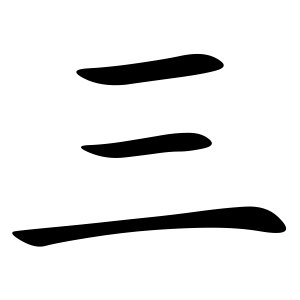三
- three, number 3, third;
Etymology
It is an ideogram, modeled after the image of three drawn lines. Since it's shaped as 一 (one) above 二 (two), it can also be interpreted as "one added to two makes three."
The numbers 1 to 3 are based on the actual number of strokes they contain, resembling the quantity they represent; numbers after that do not follow this pattern.
Usage in Korean
Words that derived from 三
Alternative forms
Alternate or variant forms of 三 include 參, 参, 叁, 弎, 𢦘, and 𣬛. Among them, 參 (three/ participate) is a variant form used especially in official documents to prevent tampering—such as adding strokes to change 三 into 五 (five), for example.
In Simplified Chinese (used in Mainland China), 参 is used for the meaning "to participate" (with the bottom 三 slanted), while 叁 is used for the pure numeral "three" (with the bottom strokes straight), to distinguish between the two meanings.
Even those unfamiliar with Chinese characters can usually read and write up to 三, as it merely involves drawing one, two, or three lines.
- 一一一 (MMM)
- ⿱ 一 二
- ⿱ 𠄟 一
